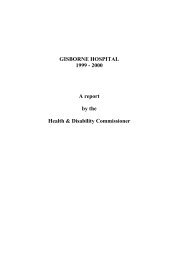09HDC01565 - Health and Disability Commissioner
09HDC01565 - Health and Disability Commissioner
09HDC01565 - Health and Disability Commissioner
You also want an ePaper? Increase the reach of your titles
YUMPU automatically turns print PDFs into web optimized ePapers that Google loves.
Opinion <strong>09HDC01565</strong><br />
Additional information from RN Ms I<br />
136. RN Ms I states that she began working in the ward in March 2008, <strong>and</strong> has previous<br />
experience in neurological intensive care, medical <strong>and</strong> surgical nursing. At the time of<br />
these events she was a level 3 nurse. She recalls being advised during her orientation<br />
to the SCU that it was usual ward practice to hold morning h<strong>and</strong>over in the seminar<br />
room, as long as all patients were stable.<br />
137. RN Ms I notes that if patients are active <strong>and</strong> alert, recording respirations at prescribed<br />
intervals may not reflect actual respiratory status. She states that it is not difficult to<br />
assess if a patient is having difficulty breathing, <strong>and</strong> that throughout her shift it was<br />
clear that Mr A was not distressed in his breathing. She states that on reflection, she<br />
―could have written a more comprehensive narrative of [her] entire shift, including the<br />
fact that [Mr A] was fully interactive <strong>and</strong> showed no sign of respiratory distress‖.<br />
138. RN Ms I notes that since these events she ensures that:<br />
h<strong>and</strong>over in the SCU is always conducted at the patient‘s bedside;<br />
the curtains are not drawn for any length of time unless the patient is attending<br />
to hygiene matters or using a bed pan;<br />
observations are recorded by way of free text in the clinical notes;<br />
for patients using a PCA pump, observations are recorded on both the PCA <strong>and</strong><br />
observations charts.<br />
139. RN Ms I‘s legal counsel, Mr P, sought expert advice from Nurse Practitioner Alison<br />
Pirret. Ms Pirret states that respiration rate is an extremely important vital sign for the<br />
early recognition of respiratory depression due to narcotic narcosis or increased<br />
intracranial pressure. Accordingly, she considers that the failure to record respiratory<br />
rate in this situation reflected an unacceptable st<strong>and</strong>ard of nursing care. However, Ms<br />
Pirret states further that departmental or organisational factors may have contributed<br />
to RN Ms I‘s failure in this regard. She notes that the neurosurgical observation chart<br />
does not have a specific place to record this <strong>and</strong> states that ―this risks sending<br />
messages to nursing staff that the respiration rate is of less importance when<br />
compared to other neurological observations‖. She also states that respiration rate has<br />
historically been poorly documented by nurses, <strong>and</strong> that the introduction of the early<br />
warning scoring systems into New Zeal<strong>and</strong> hospitals in recent years has been ―an<br />
attempt to ensure all vital signs are documented, <strong>and</strong> if abnormal, trigger a timely <strong>and</strong><br />
appropriate response‖. Ms Pirret notes that there was no such system in place on the<br />
ward at the time.<br />
Additional information from RN Ms J<br />
140. At the time of these events RN Ms J had three years‘ postgraduate experience, most of<br />
which was in acute hospital nursing. She had worked on the ward since March 2007.<br />
141. RN Ms J acknowledges that she should have documented Mr A‘s respiratory rate. She<br />
states that she was confident in her ability to recognise respiratory distress or<br />
deterioration in a patient, but appreciates that she must document the respiratory rate<br />
regardless of whether the patient is in respiratory distress, <strong>and</strong> especially when the<br />
patient is on IV narcotics.<br />
25 5 September 2012<br />
Names have been removed (except Canterbury DHB <strong>and</strong> the experts who advised on this case) to<br />
protect privacy. Identifying letters are assigned in alphabetical order <strong>and</strong> bear no relationship to the<br />
person’s actual name.
















